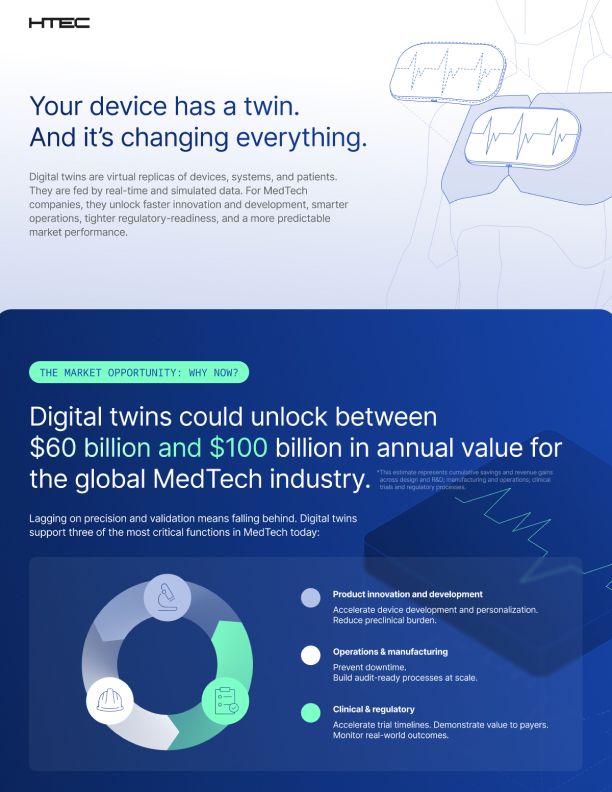Across every boardroom and industry forum, MedTech leaders are grappling with a shared challenge: how to accelerate innovation under growing operational and regulatory constraints.
Teams are under pressure to shorten development cycles, demonstrate real-world clinical performance, and deliver personalized care—without driving up cost or complexity. Yet many organizations remain hindered by siloed data, stretched R&D timelines, and a lack of synchronization between regulatory, clinical, and manufacturing functions.
In this environment, digital twins are emerging as a critical infrastructure—not just for devices, but for decision-making. These dynamic, virtual models provide a real-time, data-rich mirror of physical systems, devices, or even patients—allowing companies to simulate, test, optimize, and personalize across the product lifecycle. For MedTech innovators looking to build smarter, safer, and more adaptive solutions, digital twins are rapidly moving from experimental concept to industry standard.
Market momentum: Digital twins move from concept to core strategy
The adoption of digital twins in healthcare is accelerating. According to a 2025 Research and Markets report, MedTech firms are leveraging them to simulate device performance, optimize treatment strategies, and streamline regulatory validation. The global healthcare digital twin market is projected to grow from $2.94 billion in 2025 to $14.29 billion by 2029, with a compound annual growth rate nearing 50%.
What’s driving this growth?
- In silico design & testing: Digital twins eliminate the need for repetitive prototyping by simulating real-world conditions in silico.
- AI-powered personalization: Patient-specific models built from imaging, genomic, and telemetry data enable tailored treatment planning.
- Operational resilience: Twins model entire production environments, enabling predictive maintenance, process optimization, and adaptive scale-up.
- Regulatory flexibility: Programs such as the FDA’s Digital Health Software Precertification Pilot encourage the use of virtual evidence and real-time data in approval pathways.
This momentum reflects a broader shift: MedTech companies are increasingly investing in digital infrastructure that reduces risk while accelerating innovation.
Digital twins: Strategic infrastructure for MedTech products
A digital twin is more than a model—it’s a live, evolving replica of a physical entity, driven by sensor data, clinical insights, and simulation inputs. This twin can represent a device, a production line, or even a segment of a patient’s anatomy and physiology.
For MedTech companies, the value lies in its ability to:
- Simulate failure modes and performance variables before physical prototyping.
- Bridge silos by providing a common, traceable model for R&D, software, quality, and regulatory teams.
- Support personalization at scale by adapting to patient-specific inputs dynamically.
In regulated, high-stakes environments, digital twins enable new levels of agility and confidence—allowing companies to engineer for precision, compliance, and clinical readiness across the entire product lifecycle.
Precision by design: Simulating patient-centered use cases
At the earliest stages of development, digital twins empower engineers to model how a device will interact with real human anatomy—before a single prototype is built.
How it works:
- 3D anatomical reconstruction using tools like SimpleITK, 3D Slicer, or ITK-SNAP.
- Simulation of device interaction via finite element tools like SimVascular, COMSOL, or Ansys.
- Real-time feedback loops powered by GPU-accelerated computing for faster iteration.
How it’s applied: Johns Hopkins digital heart twin
Researchers at Johns Hopkins Medicine developed a digital twin platform that simulates arrhythmia and cardiac function using patient-specific imaging and electrophysiological data. Surgeons now use this twin to model ablation procedures in advance, improving precision and reducing procedural risk.
Thanks to real-time simulation pipelines, what once took hours now takes seconds—enabling clinical integration at scale.
Why it matters
- Time-to-insight is compressed, allowing rapid iteration on design variants.
- Clinical diversity is baked in, with simulation across a spectrum of anatomies and comorbidities.
- Safety and efficacy are improved, even before first-in-human use.
By front-loading precision and personalization into the design process, digital twins help MedTech companies de-risk development, reduce costs, and accelerate breakthrough innovations.
Product development: Connecting disciplines through shared simulation
Once a design transitions into development, coordination across functions becomes critical—but many MedTech teams still operate in silos. Misalignment between engineering, software, clinical, and regulatory teams often leads to delays, duplicated effort, and increased risk.
Digital twins solve this by offering a common, continuously updated model that teams can collaborate around in real time. This shared virtual environment allows parallel engineering, cross-functional validation, and earlier detection of system-level impacts.
How it works:
- System-level modeling via platforms like Siemens NX, Dassault 3DEXPERIENCE, or Azure Digital Twins.
- Behavioral simulations of device performance under firmware or software changes.
- Virtual UX testing and human factors evaluation using Unity or Unreal Engine for interface validation before hardware is built.
- Integration with regulatory and clinical systems through middleware connectors (e.g., FHIR, HL7, or custom APIs).
How it’s applied: Philips – Azurion image‑guided therapy platform
During the product development phase of its Azurion image‑guided therapy system, Philips created a digital twin that enabled full simulation of hardware components (imaging gantry, C‑arm mechanics, X‑ray system), software-controlled image display, and operator workflows. The virtual environment allowed engineering, software, clinical, and regulatory teams to test system behavior under real clinical scenarios (e.g., live imaging, table‑side control, emergency switching), refine user interface and safety‑critical functions, and reduce the number of pre‑launch prototypes needed through early verification of subsystem integration. Additionally, early alignment on human‑machine interface usability and safety validation enabled them to accelerate regulatory submission.
As a result, Philips achieved statistically significant improvements—for instance, a 17% reduction in procedure time and a 12% reduction in prep time in simulated clinical settings—supporting readiness for regulatory review and clinical adoption.
Why it matters
- Shortens development cycles by enabling real-time collaboration and parallel validation.
- Improves risk detection, simulating edge cases before they manifest physically.
- Facilitates system traceability, helping teams meet both design control and quality system requirements.
By making development a shared, adaptive process rather than a linear handoff, digital twins bring MedTech teams into alignment—and keep innovation on track.
Manufacturing: From reactive operations to predictive control
No matter how innovative a device may be, it won’t succeed unless it can be produced reliably, at scale, and with traceability.
Yet many MedTech manufacturers still rely on manual data collection, reactive maintenance, and batch-based production systems.
Digital twins transform manufacturing from reactive to predictive, enabling real-time insight into plant conditions, proactive risk mitigation, and optimized throughput—without compromising quality or compliance.
How it works:
- IoT telemetry collection via sensors tracking torque, temperature, vibration, cycle time (e.g., Bosch IoT Suite, Siemens Edge).
- Process simulation through AnyLogic, FlexSim, or Siemens Tecnomatix for discrete-event and continuous flow modeling.
- Analytics and monitoring via Azure Digital Twins, AWS SiteWise, or MindSphere.
- Predictive ML pipelines developed in Databricks, AWS SageMaker, or Anaconda, supporting real-time failure detection and optimization scenarios.
How it’s applied: GSK, Siemens & ATOS – Vaccine production twin
GSK deployed a digital twin of its vaccine manufacturing line using Siemens’ Tecnomatix and industrial IoT stack. This allowed the team to simulate chemical workflows, predict equipment degradation, and adjust parameters in real time to maintain batch quality. Integration with sensors, process analytical technology (PAT), Totally Integrated Automation Portal (TIA Portal), and Simulation software powered by machine learning created a closed-loop feedback mechanism to predict the quality of the adjuvant, monitor complex factory processes, and predict how any changes might affect them.
Why it matters
- Prevents downtime by anticipating maintenance needs before failure occurs.
- Improves yield and quality using simulation-informed process control.
- Enables traceability with continuous data capture across equipment, materials, and workflows.
With digital twins, manufacturing becomes a strategic asset—capable of adapting, learning, and optimizing continuously, even under pressure.
Post-market surveillance: Closing the loop with real-time insight
Product launch is not the end of the MedTech journey—it’s the beginning of continuous performance monitoring across diverse clinical contexts. Yet most post-market systems still rely on retrospective data: delayed failure reports, incomplete device usage logs, and slow R&D feedback loops.
Digital twins enable proactive, real-time surveillance by mirroring deployed devices, tracking usage patterns, and simulating emerging risks—based on actual patient and environmental conditions.
How it works:
- Virtual device mirroring captures configuration, usage, and patient context in real time.
- IoT data streaming from fielded devices using platforms like AWS IoT Greengrass, Azure Sphere, or PTC ThingWorx.
- Behavioral simulation to detect drift from expected norms, signal anomalies, and run “what-if” risk scenarios.
- Regulatory traceability and reporting via automated evidence capture tools and PMCF-ready audit logs.
How it’s applied: Neurotwin – Digital twins for neurological interventions
The EU-funded Neurotwin project is building personalized digital brain models to monitor patients with epilepsy and neurodegeneration. Each twin is continuously updated with EEG telemetry, behavioral data, and therapeutic response. The system anticipates deterioration, simulates treatment pathways, and supports dynamic clinical decision-making.
Why it matters
- Identifies risk before failure by detecting anomalies in real-world performance.
- Accelerates root cause analysis using simulated replicas to recreate events.
- Closes the loop to R&D, enabling continuous design improvement based on actual use and patient outcomes.
With digital twins, surveillance evolves from compliance obligation to continuous safety infrastructure—reducing risk, improving outcomes, and fueling the next generation of smarter products.
Regulatory & clinical validation: Virtual evidence, real-world confidence
Clinical trials and regulatory submissions are increasingly expensive, slow to recruit, and underpowered for edge cases. Traditional approaches struggle to reflect the diversity of real-world patient populations or keep pace with iterative device updates.
Digital twins offer a powerful complement to physical trials by enabling in silico testing, virtual evidence generation, and continuous validation. Regulators are beginning to accept virtual evidence as part of review packets—particularly when simulations are rigorously validated.
How it works:
- In silico trial generation using simulation platforms like Sim4Life, SimVivo, or OpenSim.
- Clinical outcome modeling driven by ML models in Databricks or Azure ML, stratified across comorbidities and demographics.
- Real-time feedback from clinical telemetry via FHIR-compliant EHR connectors and implantable or wearable sensors.
- Visualization and review tooling built in Unity or custom regulatory dashboards with automated evidence capture.
How it’s applied: NHS & Imperial College – Heart Twins for Pulmonary Hypertension
In the UK, Imperial College and the National Health Service (NHS) are leveraging digital heart twins to model outcomes in pulmonary arterial hypertension. These twins simulate patient-specific cardiac responses using imaging, implant telemetry, and real-world vitals. The goal: anticipate deterioration and personalize treatment dynamically—without enrolling thousands of patients into costly, slow-moving trials.
Why it matters
- Expands trial reach by simulating outcomes across large, diverse virtual cohorts.
- Reduces regulatory burden, with faster evidence generation and virtual validation.
- Improves safety and personalization by continuously refining models as real-world data arrives.
By enabling more adaptive, data-rich approaches to validation, digital twins help MedTech firms shorten time-to-approval and increase confidence in clinical performance—at scale.
What to look for in a digital twin partner(s)
Digital twins are built in code—but implemented through collaboration. Success depends not only on the technology stack, but on your partner’s ability to translate clinical, regulatory, and engineering needs into scalable, validated systems.
In practice, building a high-fidelity digital twin often requires contributions from multiple partners—because no single organization typically holds the full range of capabilities across AI modeling, simulation physics, medical domain expertise, device integration, and compliance frameworks. R&D teams may work with simulation platform vendors, data infrastructure providers, regulatory consultants, and MedTech engineers in parallel. Choosing the right lead partner means selecting someone who can not only deliver their part—but also orchestrate across disciplines to ensure the digital twin is clinically relevant, technically sound, and regulator-ready.
Here’s what to evaluate:
1. Multi-domain expertise
Look for a team that brings together:
- Biomedical modeling capabilities (anatomical simulation, computational physiology)
- Regulatory and quality knowledge (ISO 13485, IEC 62304, FDA 21 CFR Part 11)
- IoT and cloud-native architecture (real-time streaming, security, edge computation)
2. Simulation & modeling toolchain
Ask about their experience with:
- Physics-based solvers (e.g., SimVivo, Ansys, COMSOL)
- 3D anatomical reconstruction (e.g., SimpleITK, 3D Slicer)
- Real-time engines (e.g., Unity, Unreal, AnyLogic)
- ML infrastructure (e.g., Azure ML, PyTorch, Databricks)
Do they have clinicians or life science experts on staff to validate assumptions?
3. Interoperability & data integration
Your partner should support integration with:
- EHRs and clinical systems (FHIR, HL7)
- MES/QMS platforms and regulatory tools
- Wearable, implantable, or sensor data streams
- APIs or middleware for multi-source ingestion and synchronization
4. Validation & regulatory readiness
Look for:
- Defined processes for model validation & verification (V&V)
- Experience with in silico trial submissions and virtual evidence generation
- Documentation and quality systems for audit and traceability
5. Product-driven mindset
A digital twin is not a proof of concept—it’s a strategic product capability. The right partner should:
- Support continuous improvement and version control
- Build infrastructure that scales across therapies, sites, or patient cohorts
- Share ownership of outcomes across the full product lifecycle
The precision advantage: Digital Twin as a strategic differentiator
Medtech innovation is entering a new phase—one where precision, personalization, and regulatory resilience must coexist at scale. Digital twins are not just enabling this shift—they are defining it.
The cost of inaction is growing. Companies that delay adoption risk falling behind on every strategic front:
- Longer time-to-market, as competitors compress R&D cycles using virtual simulations.
- Higher operational costs, driven by inefficiencies in manufacturing and reactive maintenance.
- Increased regulatory risk, due to a lack of real-time traceability and digital validation tools.
- Lost market share, as personalized, data-driven devices become the baseline—not the differentiator.
In an AI-powered future where innovation is constant and compliance is non-negotiable, digital twins enable teams to move from reactive to predictive, from siloed to integrated—and from generalized solutions to precise, patient-centered therapies.
In the end, precision and predictability are competitive advantages. For companies ready to lead in this next era, the opportunity isn’t just to build better devices—it’s to design better systems, better outcomes, and better futures.






